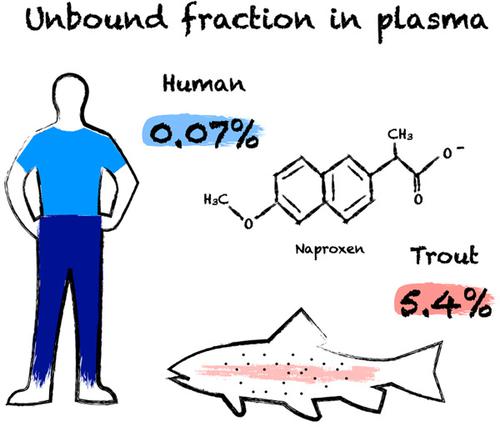当前位置:
X-MOL 学术
›
Environ. Toxicol. Chem.
›
论文详情
Our official English website, www.x-mol.net, welcomes your
feedback! (Note: you will need to create a separate account there.)
Trout and Human Plasma Protein Binding of Selected Pharmaceuticals Informs the Fish Plasma Model
Environmental Toxicology and Chemistry ( IF 3.6 ) Pub Date : 2020-11-17 , DOI: 10.1002/etc.4934 Luise Henneberger 1 , Nils Klüver 1 , Marie Mühlenbrink 1 , Beate Escher 1, 2
Environmental Toxicology and Chemistry ( IF 3.6 ) Pub Date : 2020-11-17 , DOI: 10.1002/etc.4934 Luise Henneberger 1 , Nils Klüver 1 , Marie Mühlenbrink 1 , Beate Escher 1, 2
Affiliation

|
Concerns are increasing that pharmaceuticals released into the environment pose a risk to nontarget organism such as fish. The fish plasma model is a read-across approach that uses human therapeutic blood plasma concentrations for estimating likely effects in fish. However, the fish plasma model neglects differences in plasma protein binding between fish and humans. Because binding data for fish plasma are scarce, the binding of 12 active pharmaceutical ingredients (APIs; acidic, basic, and neutral) to rainbow trout (Oncorhynchus mykiss) and human plasma was measured using solid-phase microextraction (SPME). The plasma/water distribution ratios (D
plasma/w) of neutral and basic APIs were similar for trout and human plasma, differing by no more than a factor of 2.7 for a given API. For the acidic APIs, the D
plasma/w values of trout plasma were much lower than for human plasma, by up to a factor of 71 for naproxen. The lower affinity of the acidic APIs to trout plasma compared with human plasma suggests that the bioavailability of these APIs is higher in trout. Read-across approaches like the fish plasma model should account for differences in plasma protein binding to avoid over- or underestimation of effects in fish. For the acidic APIs, the effect ratio of the fish plasma model would increase by a factor of 5 to 60 if the unbound plasma concentrations were used to calculate the effect ratio. Environ Toxicol Chem 2022;41:559–568. © 2020 The Authors. Environmental Toxicology and Chemistry published by Wiley Periodicals LLC on behalf of SETAC.
中文翻译:

鳟鱼与选定药物的人血浆蛋白结合为鱼类血浆模型提供了依据
人们越来越担心释放到环境中的药物会对鱼类等非目标生物构成风险。鱼血浆模型是一种交叉读取方法,它使用人类治疗性血浆浓度来估计对鱼的可能影响。然而,鱼血浆模型忽略了鱼和人类之间血浆蛋白结合的差异。由于鱼血浆的结合数据很少,因此使用固相微萃取 (SPME) 测量了 12 种活性药物成分(API;酸性、碱性和中性)与虹鳟鱼 ( Oncorhynchus mykiss ) 和人血浆的结合。血浆/水分布比(D 血浆/w) 的中性和基本 API 对于鳟鱼和人血浆是相似的,对于给定的 API,差异不超过 2.7 倍。对于酸性 API,鳟鱼血浆的D 血浆/w值远低于人血浆,萘普生高达 71 倍。与人血浆相比,酸性 API 对鳟鱼血浆的亲和力较低,这表明这些 API 在鳟鱼中的生物利用度较高。像鱼血浆模型这样的交叉阅读方法应考虑血浆蛋白结合的差异,以避免高估或低估对鱼类的影响。对于酸性 API,如果使用未结合血浆浓度计算效应比,鱼血浆模型的效应比将增加 5 到 60 倍。环境毒物化学2022;41:559–568。© 2020 作者。Wiley Periodicals LLC 代表 SETAC 出版的Environmental Toxicology and Chemistry 。
更新日期:2020-11-17
中文翻译:

鳟鱼与选定药物的人血浆蛋白结合为鱼类血浆模型提供了依据
人们越来越担心释放到环境中的药物会对鱼类等非目标生物构成风险。鱼血浆模型是一种交叉读取方法,它使用人类治疗性血浆浓度来估计对鱼的可能影响。然而,鱼血浆模型忽略了鱼和人类之间血浆蛋白结合的差异。由于鱼血浆的结合数据很少,因此使用固相微萃取 (SPME) 测量了 12 种活性药物成分(API;酸性、碱性和中性)与虹鳟鱼 ( Oncorhynchus mykiss ) 和人血浆的结合。血浆/水分布比(D 血浆/w) 的中性和基本 API 对于鳟鱼和人血浆是相似的,对于给定的 API,差异不超过 2.7 倍。对于酸性 API,鳟鱼血浆的D 血浆/w值远低于人血浆,萘普生高达 71 倍。与人血浆相比,酸性 API 对鳟鱼血浆的亲和力较低,这表明这些 API 在鳟鱼中的生物利用度较高。像鱼血浆模型这样的交叉阅读方法应考虑血浆蛋白结合的差异,以避免高估或低估对鱼类的影响。对于酸性 API,如果使用未结合血浆浓度计算效应比,鱼血浆模型的效应比将增加 5 到 60 倍。环境毒物化学2022;41:559–568。© 2020 作者。Wiley Periodicals LLC 代表 SETAC 出版的Environmental Toxicology and Chemistry 。











































 京公网安备 11010802027423号
京公网安备 11010802027423号